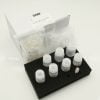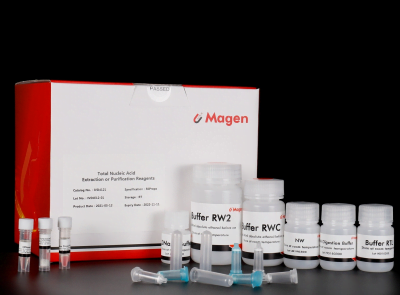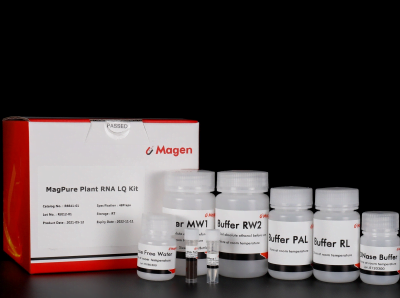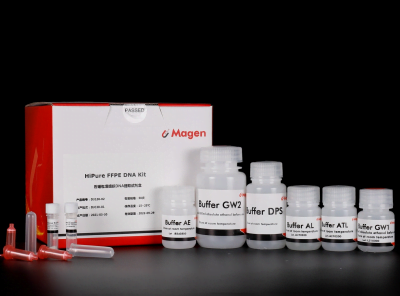- Componenti del kit di reagenti
| Specifiche | 50T | 100T |
| Gatto. NO. | SN0329 | SN0330 |
| DNA Clean-Up Columns (impostato) | 50 (impostato) | 100 (impostato) |
| RNA Extraction Columns (impostato) | 50 (impostato) | 100 (impostato) |
| RNA Extraction Buffer I | 30 ml | 2×30 ml |
| RNA Extraction Buffer IV | 30 ml | 2×30 ml |
| Inhibitor Removal Buffer | 2×30 ml | 4×30 ml |
| Tampone di lavaggio 1 | 2×15 ml | 3×15 ml |
| Tampone di eluizione | 20 ml | 20 ml |
| Proteinasi K | 1ml | 2x1 ml |
| Manuale di istruzioni | 1 | 1 |
- Magazzinaggio
Questo kit di reagenti deve essere conservato a temperatura ambiente (15-25℃) in a dry condition and is stable for 12 mesi. Proteinase K contains a stabilizer, allowing it to be transported at room temperature; Tuttavia, for long-term storage, dovrebbe essere mantenuto a -20 ℃.
- Istruzioni per l'uso del kit di reagenti
3.1 Questo kit è destinato a scopi di ricerca in biologia molecolare e non deve essere utilizzato per la diagnosi o il trattamento di malattie.
3.2 Alcuni componenti del kit contengono sostanze irritanti; è opportuno prendere le dovute precauzioni (come indossare indumenti protettivi e occhiali protettivi).
3.3 L'utilizzo di questo kit richiede apparecchiature aggiuntive come una centrifuga ad alta velocità, bagnomaria (bagno di metallo), miscelatore a vortice, etanolo anidro, azoto liquido, cloroformio, acqua deionizzata sterile, e tubi EP.
- Introduzione al kit di reagenti
The sample DNA/RNA simultaneous isolation and purification kit provide a fast and efficient purification solution for tissue sample DNA/RNA. This kit offers two sets of lysis systems, suitable for various sample tissues and cells, including most plants, animali, batteri, eccetera.
The DNA/RNA rapid purification kit can extract total DNA/RNA from samples within 1 ora. The extracted DNA/RNA can be directly used for RT-PCR, Northern blotting, eccetera. L'intero processo di purificazione non richiede reagenti tossici come il fenolo-cloroformio.
- Principi e procedure sperimentali

- Processo di estrazione
Precauzioni prima di iniziare l'esperimento:
UN. Prior to use, add the specified amount of absolute ethanol to LavareRespingente 1 according to the label on the reagent bottle, and mark a check on the label to indicate the addition of absolute ethanol.
B. Il tampone di eluizione è un 0.1x soluzione TE with a minimal amount of EDTA. Se l'EDTA ha un impatto sugli esperimenti successivi, si consiglia di utilizzare acqua deionizzata sterile come sostituto del tampone di eluizione.
C. RNA Extraction Buffer I is designed for the extraction of plant and fungal samples, while RNA Extraction Buffer IV is primarily used for animal tissues, sangue, and other sample tissues.
- Elaborazione del campione:
- Plant/animal tissue materials: Collect samples using liquid nitrogen, grind the collected material directly in liquid nitrogen, and proceed to step 2 (recommended to use RNA Extraction Buffer I).
- Cell tissues: Centrifuge and collect <107 suspended cells in a 1.5 provetta da centrifuga da ml, quickly proceed to step 2 (recommended to use RNA Extraction Buffer III).
- Aggiungere 500μl RNA Extraction Buffer I/RNA Extraction Buffer IV, 10µl di proteinasi K, vortex and mix thoroughly. Ensure gentle mixing in this step to prevent mechanical cutting of tissue DNA and reduce DNA yield.
- Transfer the lysate to a Purificazione del DNA column, centrifugare a 13,000 giri al minuto per 2 minuti, collect the filtrate (RNA is present in the filtrate). A questo punto, DNA is adsorbed on the DNA column and can be briefly stored at 4°C while simultaneously collecting RNA in the next steps.
(Nota: If the sample is plant tissue, centrifugare a 13,000 giri al minuto per 10 minuti, and add the supernatant to the DNA binding column.)
- Precisely estimate the volume of the filtrate, aggiungere 5 times thevolume of absolute ethanol, mescolare accuratamente. Se si verificano precipitazioni, it does not affect subsequent experiments.
- Add the obtained liquid to the RNA extraction purification column (circa 650-700μl ogni volta), centrifugare al massimo 8,000 giri al minuto per 1 minuto, smaltire il liquido di scarto raccolto, e reinserire il tubo di raccolta nella colonna di purificazione per il passaggio successivo.
- Ripeti il passaggio 5, add the remaining liquid to the RNA extraction purification column, centrifugare al massimo 8,000 giri al minuto per 1 minuto, discard the waste liquid and collection tube, place the RNA extraction purification column in a new collection tube, and prepare for simultaneous collection of DNA.
- Aggiungere 600μl Inhibitor Removal Buffer to the DNA extraction purification column and RNA extraction purification column, centrifugare al massimo 8,000 giri al minuto per 1 minuto, eliminare il liquido di scarto, and reinsert the DNA/RNA purification column into the collection tube for the next step.
- Aggiungere 700μl Wash Buffer 1 to the DNA extraction purification column and RNA extraction purification column, centrifugare a 14,000 giri/min (20,000× g) per 2 minuti. Extend centrifugation time appropriately to ensure the membrane is thoroughly dried.
(Nota: Confirm that absolute ethanol has been added to Wash Buffer 1. The presence of ethanol has a significant impact on subsequent experiments, so membrane drying is crucial. Dopo la centrifugazione, ensure no ethanol is present before elution, then discard the waste liquid and collection tube.
After washing with Wash Buffer 1, the membrane of the RNA purification column should only have a slight color. Dopo la centrifugazione, carefully remove the RNA purification column, ensuring no contact with the collection tube to avoid ethanol interference.)
- Place the DNA/RNA purification column into a new centrifuge tube, drip 50-100 μl Elution Buffer onto the membrane, incubate at room temperature for 5 minuti (15°C-25°C), centrifugare al massimo 8,000 giri al minuto per 1 minuto.
(Nota: Eluting nucleic acids with 50 μl Elution Buffer can increase the nucleic acid concentration but decrease the total nucleic acid yield.)
- Nota:
- Generalmente, larger elution volumes result in higher elution efficiency, but to increase nucleic acid concentration, the elution volume can be reduced, but not below 50 ml.
- RNA, in the presence of RNA Extraction Buffer I/RNA Extraction Buffer III, is not degraded by RNAse but should be distinguished from DNA in subsequent experiments. Use RNAse-free consumables for RNA separation whenever possible.












Recensioni
Non ci sono ancora recensioni.